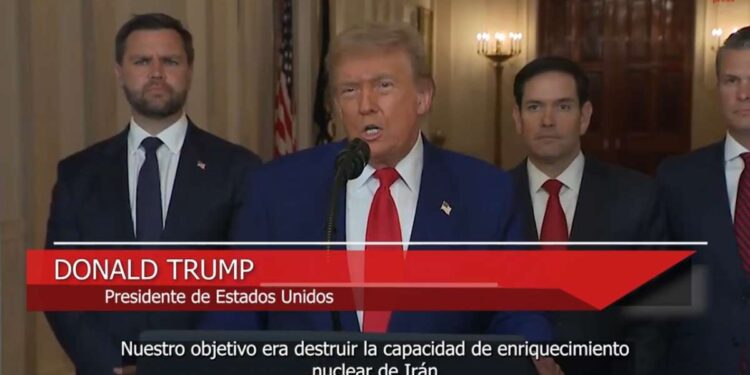This article is authored by former military officer and security expert Ramón Cuerda Riva and has been provided by the media outlet Escudo Digital.
_______________________________________________________________________________
On June 21, 2025, under the orders of President Donald Trump, the United States carried out an airstrike on three Iranian nuclear facilities—Fordow, Natanz, and Isfahan—in support of a coordinated campaign with Israel.
The operation employed a combination of B-2 stealth bombers equipped with bunker-buster bombs (GBU-57/MOP) and Tomahawk missiles launched from submarines. Trump hailed the mission as a “spectacular success,” claiming the facilities were “completely destroyed.” According to the White House, all aircraft returned safely and undamaged after the strike.
Iran confirmed the attacks but downplayed their impact, stating that there was no significant radioactive contamination. Israel, led by Prime Minister Netanyahu, publicly praised the action. Meanwhile, international organizations like the United Nations expressed alarm over the risk of regional escalation.
In the United States, reactions were divided. Republican leaders such as Lindsey Graham defended the move as a sound decision, while Democrats—and some Republicans—criticized Trump for acting without Congressional authorization. Critics have invoked the War Powers Resolution to challenge the constitutionality of the action.
The War Powers Resolution is a key piece of U.S. legislation regulating when and how the president may deploy military forces without prior Congressional approval. Passed after the Vietnam War, it was intended to limit presidential power to engage in armed conflicts unilaterally.
It mandates that the president must notify Congress within 48 hours of deploying troops into combat or hostile situations. Additionally, it imposes a 60-day limit (plus a 30-day withdrawal period) unless Congress grants a formal authorization for the use of military force (AUMF) or declares war. If no authorization is granted, forces must be withdrawn once the time limit expires.
In this case, many members of Congress—especially Democrats and some Republicans—argue that Trump violated the War Powers Resolution by launching a major offensive without prior approval. Several lawmakers have cited the law to demand troop withdrawal and call for sanctions against the president for exceeding his powers.
This strike marks the most significant direct U.S. military intervention in Iran in decades, signaling a shift after failed diplomatic efforts between April and June 2025.
Experts warn of potential regional escalation, with possible retaliatory strikes against U.S. bases, allied ships in the Gulf, or vital energy routes.
The long-term impact on Iran’s nuclear program remains unclear. While Iran insists its capabilities are intact, analysts believe it may recover in time. Trump, however, claims the key nuclear sites were destroyed and that Tehran “must now choose peace.”
President Trump has declared that the U.S. airstrikes on Iran’s three main nuclear facilities—Natanz, Isfahan, and Fordow—resulted in the destruction of their primary enrichment capabilities. Iranian media later acknowledged that part of the Fordow plant had been hit. “Everyone heard those names for years as they built this horrible, destructive enterprise. Our mission was to destroy Iran’s nuclear enrichment facilities,” Trump stated, adding that the operation was a “spectacular military success.”
This direct engagement followed over a week of Israeli strikes aimed at systematically dismantling Iran’s air defenses and offensive missile capabilities, as well as targeting enrichment facilities.
Fordow Enriched Uranium to 83.7%
Buried under a mountain and protected by anti-air defenses, Fordow was designed to withstand airstrikes. Disabling Fordow—diplomatically or militarily—has long been seen as essential to preventing Iran from developing nuclear weapons, especially after the IAEA found that the site had enriched uranium to 83.7%, just shy of the 90% required for weapons-grade material.
Fordow is Iran’s most secretive and heavily fortified nuclear site. Its inclusion in the June 21 strike marks a critical escalation. Located near the city of Qom in northern Iran, it is carved deep into a mountain, making it extremely difficult to destroy using conventional weaponry.
It remained secret until 2009, when it was exposed by the U.S., UK, and France. Although its operations were restricted under the 2015 nuclear deal (JCPOA), Iran resumed and expanded its activities following the U.S. withdrawal from the pact in 2018.
Due to its depth and fortifications (more than 80 meters underground), Fordow poses a serious challenge to military strikes. It is believed the U.S. used GBU‑57A/B MOP (Massive Ordnance Penetrator) bombs, designed to penetrate deep bunkers.
As noted, Trump claimed Fordow was “completely neutralized.” Iran, however, maintains that damage was minimal, citing the site’s mountainous protection. The reality likely lies somewhere in between—some installations may have been damaged, but not entirely destroyed.
Israel reportedly requested U.S. use of the GBU-57 Massive Ordnance Penetrator, a 30,000-pound (13,668 kg) bunker-busting bomb that relies on weight and kinetic energy to reach buried targets before detonating. Only the U.S. possesses aircraft capable of deploying it—the B-2 stealth bomber.
After the attacks, Prime Minister Benjamin Netanyahu praised Trump’s actions, saying America’s “just and admirable power will change history.” In a video address, he added that the U.S. “achieved what no other country in the world could achieve.”
Trump, in turn, said he and Netanyahu “worked as a team like perhaps no other team has ever worked before” and that together they had taken major steps to “erase this horrific threat to Israel.”
The GBU-57 carries a conventional warhead and is believed to penetrate around 200 feet (61 meters) underground before detonation. Multiple bombs can be dropped in succession to progressively deepen the penetration.
Trump told Fox News that six bunker-busters were dropped on Fordow, while 30 Tomahawk missiles were launched at other nuclear sites, including Natanz.
Natanz, Iran’s other key enrichment center, was targeted by Israel earlier in its campaign. Diplomats familiar with Natanz describe its underground enrichment facility as being located three stories below ground. There has long been debate over the extent of damage airstrikes could inflict.
Natanz, located in Isfahan Province in central Iran, is surrounded by mountains, offering strategic defense. Its uranium enrichment plant houses thousands of centrifuges critical for both civilian nuclear energy and potential weapons applications.
It also includes highly fortified underground facilities, built to resist conventional strikes. As with Fordow, the U.S. reportedly employed GBU‑57A/B MOP bombs dropped from B-2 bombers. Trump claimed the site was “completely neutralized,” but Iran again insists that critical infrastructure survived and that the attack failed to cripple its nuclear capacity.
Natanz has been targeted before. In 2010, it was hit by the Stuxnet cyberattack—developed by the U.S. and Israel—and in 2020 and 2021, mysterious explosions occurred, likely the result of Israeli sabotage. Targeting Natanz constitutes a serious red line for Iran and could prompt military retaliation or withdrawal from international agreements.
Isfahan Nuclear Facility
The Isfahan facility includes a Uranium Conversion Facility (UCF), where yellowcake (uranium oxide) is converted into UF6 gas—critical to the nuclear fuel cycle. The U.S. used precision-guided missiles, likely launched from submarines or bombers, to avoid secondary nuclear explosions. Iranian officials claim no radioactive material was released, though independent analysts are still verifying the actual damage.
The bombing of Isfahan carries symbolic and provocative weight. It directly targets one of Iran’s most iconic cities—its third-largest, located in the heart of the country. A historic Safavid capital, Isfahan is a cultural, industrial, and military hub with a dense population, heightening the risk of an Iranian military response or retaliation against U.S. or allied interests.
What Comes Next? The Name to Watch: Karg
Everything now depends on Tehran’s response. The next potential flashpoint is Iran’s strategic island in the Persian Gulf: Karg. Though not yet attacked, its geopolitical and military significance makes it a key site to watch.
Located in the northern Persian Gulf, about 25 kilometers off Iran’s coast, Karg belongs to Bushehr Province—home to Iran’s only operational civilian nuclear plant.
It is Iran’s main oil export terminal; nearly 90% of the country’s crude exports pass through the island. It houses massive storage tanks and specialized supertanker ports.
Iran has also partially militarized the island, installing air defenses and a naval presence. It has been reinforced multiple times in response to threats from Israel and the U.S.
During the Iran–Iraq War (1980–1988), Karg was repeatedly bombed to disrupt Iran’s oil supply. In 2021, mysterious explosions occurred there, attributed to Israeli sabotage or internal accidents.
Following the U.S. strikes on Fordow, Natanz, and Isfahan, Karg is seen as a potential target—either for Iranian retaliation or for preemptive attacks by the U.S. or Israel if Iran escalates.
What If Karg Is Attacked?
A strike on Karg could spark a direct U.S.–Iran clash in the Persian Gulf. It would disrupt global oil flows, immediately spiking crude prices and shaking the global economy. Iran could respond by partially closing the Strait of Hormuz, through which about 20% of the world’s oil supply passes. From June 21 onward, the world will be watching closely to see whether we enter a phase of escalation—or negotiation.







